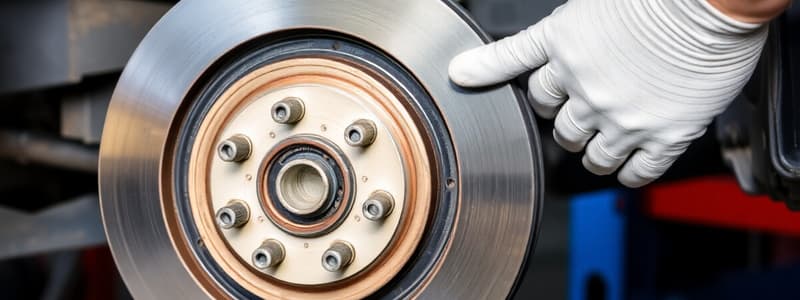Podcast
Questions and Answers
What is the primary function of drum brakes in a vehicle?
What is the primary function of drum brakes in a vehicle?
- To provide a smooth ride and reduce vibrations during braking.
- To transfer mechanical energy into thermal energy, stopping the vehicle. (correct)
- To improve fuel efficiency by minimizing friction in the braking system.
- To convert hydraulic pressure into rotational motion, moving the wheels.
What is the main reason why drum brakes are commonly used in vehicles?
What is the main reason why drum brakes are commonly used in vehicles?
- They are more affordable and require less maintenance than disc brakes. (correct)
- They offer a more responsive braking feel compared to disc brakes.
- They are more effective in extreme weather conditions, such as rain or snow.
- They provide better braking performance at high speeds, reducing stopping distance.
What is the role of the wheel cylinder in a drum brake system?
What is the role of the wheel cylinder in a drum brake system?
- To provide a smooth and quiet braking experience by reducing friction in the system.
- To adjust the brake shoe position automatically, ensuring proper brake pad wear.
- To convert hydraulic pressure into mechanical force, pushing the brake shoes against the drum. (correct)
- To control the flow of brake fluid to the system, maintaining optimal hydraulic pressure.
What is the purpose of the self-adjuster in a drum brake system?
What is the purpose of the self-adjuster in a drum brake system?
Why is it important to remove both brake shoes and the self-adjuster as one unit during drum brake replacement?
Why is it important to remove both brake shoes and the self-adjuster as one unit during drum brake replacement?
Which of these components is NOT directly involved in the braking process of a drum brake system?
Which of these components is NOT directly involved in the braking process of a drum brake system?
What is the main advantage of drum brakes over disc brakes in some applications?
What is the main advantage of drum brakes over disc brakes in some applications?
What is a potential disadvantage of drum brakes compared to disc brakes?
What is a potential disadvantage of drum brakes compared to disc brakes?
Flashcards
What are drum brakes?
What are drum brakes?
Drum brakes are a type of brake commonly used in vehicles with two or four wheels. They work similarly in both motorcycles and cars. Car drum brakes usually rely on a hydraulic brake system, using hydraulic pressure to apply force to the brake pads.
How do drum brakes work?
How do drum brakes work?
Drum brakes use hydraulic pressure to apply force to the brake pads. This pressure is created by the brake pedal, transmitted through the hydraulic system, and ultimately acts on the brake pads.
How do the brake pads and drum interact?
How do the brake pads and drum interact?
When the brake pedal is pressed, hydraulic pressure activates the wheel cylinder. The wheel cylinder then pushes the brake shoes outward, pressing them against the brake drum, creating friction and slowing the vehicle down.
What is the role of the brake shoes?
What is the role of the brake shoes?
Signup and view all the flashcards
What is the brake drum?
What is the brake drum?
Signup and view all the flashcards
What is the wheel cylinder's role?
What is the wheel cylinder's role?
Signup and view all the flashcards
What is the function of the self-adjuster?
What is the function of the self-adjuster?
Signup and view all the flashcards
What is the process of replacing drum brakes?
What is the process of replacing drum brakes?
Signup and view all the flashcards
Study Notes
Drum Brake Replacement Techniques
- Drum brakes are a crucial component for automotive braking systems, known for durability and reliability
- Understanding the process of replacing drum brakes is vital for maintaining vehicle safety and performance
- Drum brakes have several key components that work together, including brake shoes and springs, wheel cylinders, and adjusters, converting mechanical energy to thermal energy to slow or stop the vehicle
- Replacing drum brakes involves a systematic approach of disassembly, inspection, adjustment, and reassembly to ensure optimal performance and safety
Drum Brake Components
-
Backing Plate: A thin, metal-based band placed behind the drum brake; serves as a protective shield for other components; circular shape with holes and protrusions to match the standard drum brake part
-
Wheel Cylinders: Components that convert fluid pressure into mechanical motion; vital for the braking mechanism; dual piston wheel cylinders are common due to accompanying leading and trailing drum types; these cylinders include housing, bleeder nut, piston boot, spring and piston
-
Brake Shoes and Pads: Often found in drum brakes; a brake shoe or pad facilitates braking; brake shoes have a circle shape consisting of two semicircle shoes, and brake pads are placed on the brake shoes; brake pads are made of organic ceramic
-
Return Spring: An important component in drum brake systems; responsible for returning the brake shoe to its original position upon release of pressure from brake lever or pedal; it includes an upper spring and a lower spring, with the latter maintaining the position of the brake shoes on the adjuster
-
Brake Shoe Holder: Attaches the brake shoes to the backing plate in the drum brake system; consists of various parts, including pins, springs, and a pressure plate, for added support and stability to the drum brakes
-
Brake Shoe Adjuster: Located at the bottom of the drum brake; its shape resembles a screw on an adjuster; adjusting the gap between the drum brake pads and the drum surface to ensure smooth braking operation
-
Parking Brake Lever: A lever exclusively found in cars and designed for parking brake functionality; its construction includes two levers - park brake lever and brake shoe link; one end of the lever has a hinge attached to the brake shoe, while the other is attached to the brake cable
-
Drum Brake: A component in the drum brake system, a medium for friction with brake pads to slow or stop vehicle wheels; made of cast steel with a drum or tube shape; directly connected to wheel bolts
Steps to Replace Drum Brakes
-
Step 1: Wear an asbestos respirator to protect against hazardous brake dust
-
Step 2: Remove the hubcap and loosen the lug nuts; block the front wheels with wheel chocks; jack up the car and secure it on jack stands; do not work on a car supported by a jack alone (use stands to guarantee safety).
-
Step 3: Spray the hub of the wheel with penetrating oil (like PB Blaster)
-
Step 4: Grip the brake drum edges and pull it off while wiggling it to aid removal; back off the brake adjuster to facilitate removal of the drum
-
Step 5: If brake drums are held on by screws, remove them first as per needed
-
Step 6: Examine the drum for any damage—scoring requires refacing or replacement. Take detailed pictures or drawings of the component setup before disassembling so you can put it back together correctly
-
Step 7: Place the whole brake mechanism in a container and spray it with brake cleaner to keep the dust from becoming airborne (asbestos dust is hazardous)
-
Step 8: Compare the new brake shoes with the old ones; ensure they are the same shape, holes, and width
-
Step 9: Dismantle the brake by removing the shoe return springs, detaching the parking brake lever, and removing retaining pins and springs; spread the shoes apart from the top and disengage the shoes from the wheel cylinder pins
-
Step 10: Carefully reassemble the brake components using cleaning materials and reattaching necessary parts like the return springs and parking brake lever
-
Step 11: Check the reassembled brake components against the previously taken images or detailed drawings to ensure precise assembly and accurate placement
-
Step 12: Reinstall the tire and torque the lug nuts along with reinstalling and attaching the hubcap; repeat the process on the other side; bleed the brake system and road test the vehicle to make sure everything is working properly
Studying That Suits You
Use AI to generate personalized quizzes and flashcards to suit your learning preferences.




